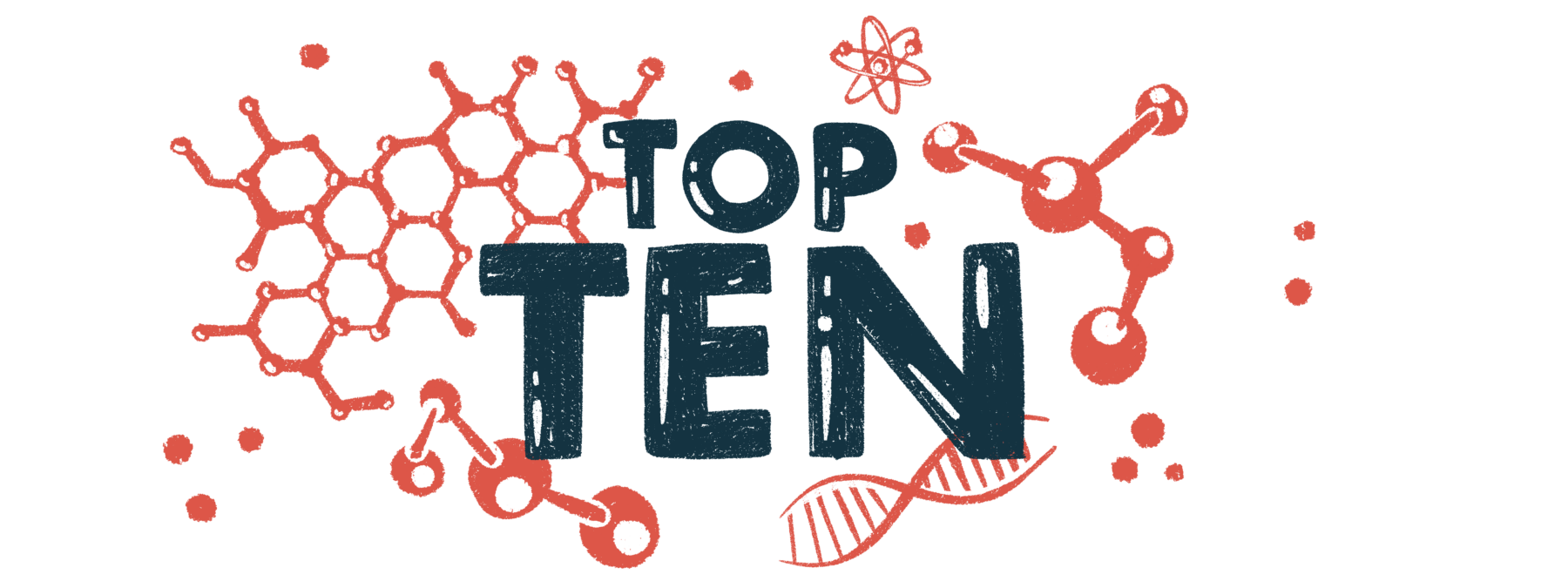Top 10 Pompe disease news stories of 2024
Treatment switching, diagnostic advances among popular topics

Last year, the team at Pompe Disease News brought our readers news on the most recent scientific advances, treatment progresses, and clinical trials for Pompe disease.
Here are the 10 most read stories we published on Pompe disease during 2024.
No. 10 – Switch from Lumizyme to Nexviazyme may improve LOPD outcomes
Switching from Lumizyme (alglucosidase alfa) to next-generation Nexviazyme (avalglucosidase alfa) — two enzyme replacement therapies (ERT) meant to replace the acid alpha-glucosidase (GAA) enzyme that’s defective in Pompe patients — improved breathing and motor function in people with late-onset Pompe disease (LOPD). These effects were seen in a small real-world study enrolling 15 LOPD patients in the U.S. Although the improvements, such as those seen in walking ability, were minimal, symptoms were eased and the benefits outweighed the losses. A young woman who had been on Lumizyme for 19 years experienced improvements in motor function and quality of life after changing to Nexviazyme.
No. 9 – Myozyme-to-Nexviadyme switch stabilized motor decline in LOPD
Switching from Myozyme (Lumizyme’s brand name outside the U.S.) to Nexviadyme (Nexviazyme in Europe) helped stabilize the worsening of motor function in adults with LOPD. That’s according to a real-life study in France, describing the switch in 29 patients experiencing a significant worsening of respiratory and/or motor function after one year on Myozyme, without additional clinical factors that could contribute to their clinical decline. However, some patients saw their respiratory function continue to decline one year after the switch.
No. 8 – Nexviazyme may provide twice the benefit than Lumizyme
LOPD patients treated with Nexviazyme may experience twice the benefit in a combined measure of respiratory function and exercise capacity, compared with patients receiving Lumizyme, after one year. The results were obtained in a new analysis of a Phase 3 trial called COMET, which jointly analyzed multiple measures and compared every person on one treatment to every person on the other treatment to see if they have a better, worse, or the same outcome. After one year, Nexviazyme led to statistical significant benefits, with improvements similar when patients were divided by sex and baseline lung function.
No. 7 – Pombiliti plus Opfolda may lead to better outcomes than Nexviazyme
A combined analysis of clinical trials and real-world data suggests that Pombiliti plus Opfolda therapy may help increase walking and breathing functions, compared with Nexviazyme, in people with LOPD. Pombiliti plus Opfolda features an ERT called cipaglucosidase alfa and a stabilizer known as miglustat. The effect was more pronounced the longer the patients had been on previous ERT. Altogether, the study analyzed four clinical trials and and open-label extension studies reflecting real-world data. However, when considering the randomized clinical trials alone (in which participants are randomly assigned to different groups), the results favored Nexviazyme.
No. 6 – FORCE-GAA effective at delivering GAA to muscle, nerve cells
A study in a mouse model of Pompe disease demonstrated that FORCE-GAA, Dyne Therapeutics’ experimental ERT, may be directly delivered to skeletal and heart muscles and to the central nervous system (CNS), consisting of the brain and spinal cord. The treatment, which features an antibody targeting a receptor in muscle and CNS cells and a functional version of the GAA enzyme, was shown to reduce glycogen accumulation in these cells with a higher efficacy and dose potency than GAA alone. The therapy also showed potential to be given in monthly dosing, instead of every two weeks as in currently available ERTs.
No. 5 – Gene-editing tool may correct mutations linked to infantile-onset disease
A gene-editing tool that can make targeted changes to DNA by converting one specific nucleotide, a DNA building block, into another was successfully used to correct infantile-onset Pompe disease-causing mutations in patient-derived cells. Researchers in the U.S. used skin cells from three children with Pompe caused by different mutations and treated them in the lab with the gene-editing machinery. A significant proportion of cells had their mutation corrected, which led to an increase in GAA production and function.
No. 4 – Two-step process may help diagnose Pompe disease
A team of scientists in Austria and the Netherlands used a two-step process to diagnose Pompe disease from individuals with symptoms that raised suspicion of the disease. In the first step, they measured GAA activity. Then, for those with lower-than-normal enzyme activity, the GAA gene was sequenced. Of 30,836 people, 723 were diagnosed with Pompe caused by 283 mutations — about a third never detected before. Some specific types of mutations were more common in different forms of Pompe disease, although no correlation could be established between genetic and clinical profiles.
No. 3 – Quantitative muscle MRI may help diagnose, monitor LOPD
A study described how specific patterns of quantitative MRI of the thigh muscles in people with LOPD may be used as a biomarker for disease diagnosis and monitoring. For instance, muscles from LOPD patients had a higher proportion of fat relative to controls, which is reflective of lower muscle quality. A higher water content in muscles, related to swelling and muscle damage, was associated with neuromuscular disease, but not specifically with Pompe.
Read this story here
No.2 – Myozyme had low efficacy on late-diagnosed LOPD case
A report described the case of a 38-year-old Iranian woman with LOPD who went undiagnosed for about 20 years, and was on a ventilator for 12 years. She experienced slightly better breathing and limb muscle strength two years after starting treatment with Myozyme. However, she remained bedridden and still needed a ventilator to breathe. Researchers said the case highlights the importance of early intervention in halting disease progression and the difficulties in treating Pompe disease when it’s diagnosed late.
No.1 – Brain blood vessel damage may be common in LOPD
According to a small study in China, signs of brain arterial damage are common in LOPD patients. These include aneurysms, a bulge in a weak point in the blood vessel wall, and abnormal splitting or narrowing of cerebral arteries. Many patients also evidenced damage to smaller brain blood vessels related to brain lesions and bleeding events. Evidence of stroke, in which blood flow to the brain is compromised due to a blockage or a vessel rupturing or bleeding, was also reported. The researchers said the results demonstrate the relevance of cerebrovascular involvement in LOPD, and that the disease should be suspected in young patients with stroke of unknown cause.
***
We hope these stories have provided helpful information for the Pompe community in 2024. We look forward to continue our news coverage in the new year, and wish all our readers a bright and happy 2025!






